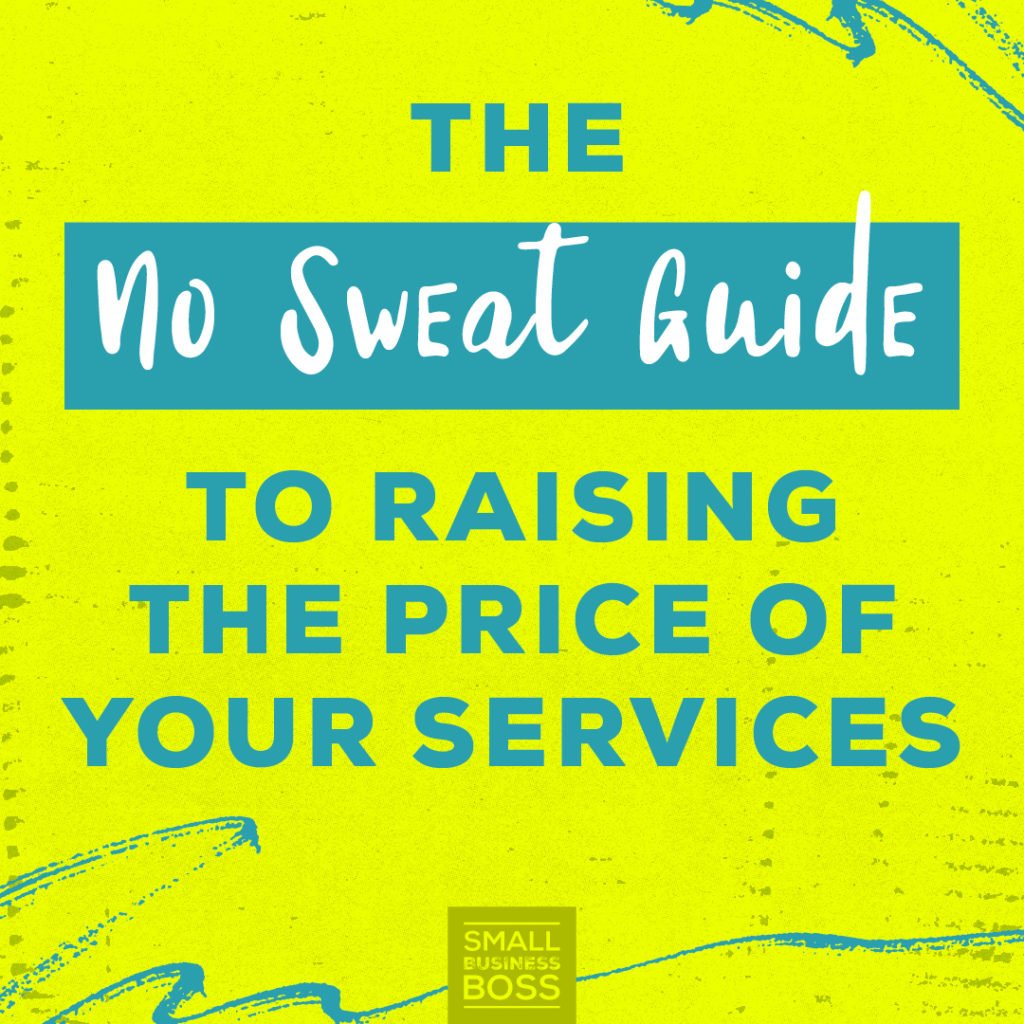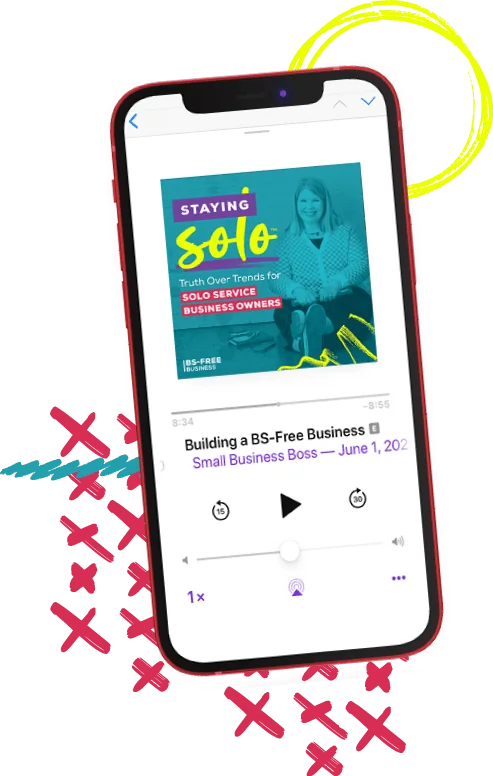
Search the site:
The No Sweat Guide to Raising the Price of Your Services
When I start working with clients, one of the first things we typically work on is raising their prices, as it’s the fastest way to help them make more money. When we start talking about this, it’s met with resistance and fear that their clients will jump ship. Trust me when I tell you that it’s extremely rare that raising the price of your services will result in the epic client meltdown that you think it will.
That’s not to say I don’t understand the concern. I do. After all, I didn’t raise my prices for EIGHT years. For eight years, I charged the same hourly rate out of fear. When I finally raised my prices, I was completely shocked at how easy it was — and no one said anything.
I want the same for you. I want you to avoid my mistake, and raise your prices so you get paid appropriately for the services you deliver.
Questions to Answer BEFORE You Raise Your Prices
For most of us, pricing is something we make up as we go. We look around, and pick a number, and go from there.
In short, our pricing isn’t strategic. It’s emotional. For you to price your services so you get paid more, you need to be able to eliminate the emotion from your pricing.
To help you do that, you need to start by understanding the value you deliver to your clients. Without that, you’re going to struggle to command higher rates.
Years ago, I was at a conference, and the speaker said something that stuck with me: “You’re like a doctor. People’s willingness to pay is proportionate to how much pain they’re in.” Now, for many of us, our clients aren’t in life-threatening situations, but they’re experiencing some challenges or discomfort that leads them to need our assistance.
As a result, you need to be able to articulate clearly how you can help them solve whatever problem they’re having.
Plus, you need to believe you’re good enough to charge higher prices. If you don’t believe that and don’t approach your pricing with confidence, it’ll be exceedingly difficult to get people to pay you those prices.
Answer these questions to help you understand your value proposition and why you charge what you do:
- What are my clients struggling with?
- What results do I deliver to my clients?
- How do these results help them succeed?
- What results am I really delivering?
- What unique skills or experience do I bring to my clients?
When you understand your value proposition, you’ll be in a better headspace to raise your prices — and do it in a way that doesn’t stress you out.
Here’s how to go about raising the price of your services without breaking a sweat:
1. Increasing Prices for All Existing Clients
If you work with clients on an ongoing or retainer basis, it may be time for you to increase prices. Start by looking at how long clients have worked with you and how long they’ve had a specific rate. From there, you’ll be able to determine who may be due for an increase (typically, if it’s been more than 12 to 18 months, they’re likely due.)
When it comes to a price increase with existing clients, you need to go in with a clear plan and proceed with caution.
First off, timing is everything. If things are going really well with a client, a price increase will be much more palatable, while if things are a bit more challenging, you may want to wait until things are running smoothly.
When the timing is right, you want to communicate the price increase with a least a two month lead time. A price increase should never ever be a surprise or something you just randomly decide on but part of a well-crafted strategy that ensures your clients feel taken care of.
In my experience, a brief, factual email informing them of the price increase is the best way to go. Curb the urge to go into detail about why you’re increasing prices, or worse yet, justify your price increase. A good client will understand that a price increase is just par for the course.
When you’re raising your prices, you want to focus on a modest increase. If you’re working in a model where you charge by the hour, an increase of more than $5 or $10 per hour may be hard to justify.
In the event a bigger price increase is necessary as you have a long-standing client at a much lower rate than your newer ones, you need a multi-phased plan to help bring them up to the current rate. Phasing the increase over time helps demonstrate that you’re committed to their business and sensitive to their budget.
2. Charging Higher Rates for New Clients
At the point you’ve got experience and worked with a number of clients, you’re in a position to pick and choose the clients you work with.
That’s where things can get interesting with new clients, as you’re much more comfortable asking for a higher price when you don’t need clients or have enough leads coming in that you can afford for someone to pass on working together.
As you’re talking with prospects and preparing new proposals, start to quote a higher project or hourly rate. Now, you may be concerned that you’re going to lose out on business, and you very well may, but the goal here is to have you working with fewer clients at a higher overall rate.
For example, if you typically charge $100/hour, and you’re interested — but not in need — of signing a new client, you may opt to quote a rate of $120/hour to see if you can command that rate. I can’t begin to tell you how many times I’ve thrown out a higher rate and the client didn’t even hesitate. Or to have quoted a higher price for the project than I thought was even possible to be met with an immediate yes.
This approach allows you to stair step prices for new clients and experiment with different price points so you can get paid more. If this makes you a bit queasy, be sure to backup your pricing with the value proposition outlined above, and you’ll quickly see that your pricing makes sense.
3. Moving to Project Pricing
My favorite way to increase prices is to ditch hourly pricing entirely and focus on project pricing. While at my agency we do a lot of retainer work that’s priced using a blended hourly rate, clients typically come in with a project first.
This approach helps us to ensure that clients are comfortable with premium pricing, and do a test run with them before we lock-in to hourly pricing.
For one-off projects, going with a project price over an hours-based model helps ensure we’re able to price this more transient work in a way that’s extremely profitable. Essentially, when someone does a project with us, they’re paying a higher rate than if we went by the hour. This flat-rate model helps ensure we’re able to service these projects in a way that’s high touch — but not at the expense of our retainer clients.
If you’re new to project pricing, start with a smaller service to ensure you’re pricing it in a way that’s profitable for you — and not resulting in you working for $10/hour as you didn’t do the math. That’ll help you get experience with what goes into managing a project with a flat-rate before you get into a larger project where things can go seriously wrong.
If you’re ready to create a signature service, project pricing is a must to make the most of this type of offering.
When you’re figuring out your project-based pricing, be sure to factor in not only your time (and pad the number of hours as it ALWAYS takes longer than you think) but the costs of any tools involved, contractors, the time you’ll spend managing the project and so forth. Those things often get missed and end up costing you in the long-run.
Get Started Now With Raising the Price of Your Services
Raising the price of your services is the easiest way for you to make more money and can be done in a way that’s not stressful or sweaty. If you need help with pricing, check out the guide below to get started.

I’m Maggie Patterson (she/her), and services businesses are my business.
I have 20+ years of experience with client services, am a consultant for agency owners, creatives, and consultants, and vocal advocate for humane business practices rooted in empathy, respect, and trust.
Read or Listen to the Latest
For Solo Business Owners

Growing a solo service business is tough.
It’s even harder when you’re bombarded with BS advice that steers you away from your values and why you started your business in the first place.
This is the podcast for solo creatives and consultants who want to remain as a team of one and have zero interest in the hustle and grind of typical business teachings.
Subscribe now and never miss an episode.
For Micro Agency Owners
Most podcasts for agency owners obsess over revenue growth as the ultimate success metric.

But here’s the truth: not everyone wants to make millions. Your goal might be to build a sustainable business that lets you have a life and doesn’t run you into the ground.
Join me as I spill my shameless confessions and share everything I’ve learned about building a micro agency that skips the BS of tired and typical agency teachings.
Follow Now on All Major Podcast Platforms








